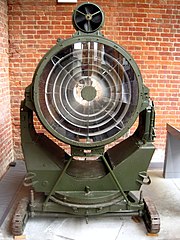27th Anti-Aircraft Brigade was an Air Defence formation of the British Army in the Second World War that served in The Blitz and later converted to infantry.
The 38th Light Anti-Aircraft Brigade was an air defence formation of Britain's Territorial Army formed just before the Second World War, which protected London and Southern England during the Blitz and later converted into an infantry formation for the liberation of Europe.
The 31st Anti-Aircraft Brigade was an air defence formation of Britain's Territorial Army from 1936 until 1948. During the Second World War it defended West Yorkshire and later participated in the North West Europe campaign.
The 32nd (Midland) Anti-Aircraft Brigade was an air defence formation of Anti-Aircraft Command in Britain's Territorial Army (TA) from 1936 to 1955, charged with defending the East Midlands of England.
The 33rd (Western) Anti-Aircraft Brigade was an air defence formation of Anti-Aircraft Command of the Territorial Army, part of the British Army, formed shortly before the outbreak of the Second World War. It defended Merseyside and West Lancashire during The Blitz.
35th Anti-Aircraft Brigade was an air defence formation of Anti-Aircraft Command in the British Territorial Army (TA) formed shortly before the outbreak of the Second World War. It defended the important naval base of Portsmouth during The Blitz.
The 54th Anti-Aircraft Brigade was an air defence formation of Britain's Territorial Army (TA) formed immediately before the outbreak of the Second World War. It was engaged in defending the West Midlands of England during the war. It comprised a varying number of searchlight (S/L) battalions and later included light anti-aircraft units. It was disbanded at the end of 1943. When the TA was reconstituted in 1947, the former 54th AA Bde was reformed as 80 Anti-Aircraft Brigade but was disbanded on 9 September 1948.
36th (Scottish) Anti-Aircraft Brigade was an air defence formation of Britain's Territorial Army, created in the period of tension before the outbreak of the Second World War. It was responsible for defending eastern Scotland.
The 73rd Searchlight Regiment was a volunteer air defence unit of Britain's Territorial Army (TA) from 1939 until 1955, at first as part of the Royal Engineers, later in the Royal Artillery. It served during the Battle of Britain and The Blitz.

The 76th Searchlight Regiment, Royal Artillery was a British Army air defence unit during World War II. It was engaged during the Battle of Britain and The Blitz, defending Royal Air Force airfields and the towns of southern England.
6th Anti-Aircraft Brigade was an air defence formation of the British Army formed during the Second World War. It served in the disastrous Norwegian Campaign in 1940 and then defended East Anglia during the Battle of Britain and The Blitz. It was reorganised to take part in the invasion of Normandy, but instead was diverted to defending Southern England against V-1 flying bombs. It was briefly recreated in the postwar Regular Army.

78th Searchlight Regiment, was an air defence unit of Britain's Royal Artillery during World War II. It protected the United Kingdom as part of Anti-Aircraft Command from the Blitz of 1940 until 1943.

79th Searchlight Regiment was an air defence unit of Britain's Royal Artillery during World War II. It protected London and South East England as part of Anti-Aircraft Command from the Blitz of 1940 until Operation Diver in 1944, after which it was disbanded.

The 132nd Light Anti-Aircraft Regiment, was an air defence unit of the British Army's Royal Artillery during World War II. The regiment was formed in March 1942 from the short-lived 85th Searchlight Regiment, Royal Artillery which had only been raised in the previous year as part of the rapid expansion of Anti-Aircraft Command. It served in Home Defence throughout the war, until disbandment in 1945.

The 84th Searchlight Regiment was an air defence unit of the British Army's Royal Artillery during World War II. It protected Humberside and the North Midlands of England as part of Anti-Aircraft Command from the Blitz of 1940 until it was disbanded in 1943.

The 128th Light Anti-Aircraft Regiment was an air defence unit of Britain's Royal Artillery during World War II. The regiment was formed in March 1942 from the short-lived 87th Searchlight Regiment, Royal Artillery, which had only been raised in the previous year as part of the rapid expansion of Anti-Aircraft (AA) defences. It served in AA Command until near the end of the war, when it was converted into an infantry battalion for garrison duties in North West Europe.

The 88th Searchlight Regiment was an air defence unit of Britain's Royal Artillery during World War II. The regiment was formed in March 1941 as part of the rapid expansion of Anti-Aircraft (AA) defences during The Blitz. It served in AA Command until disbandment in 1943.

The 90th Searchlight Regiment, Royal Artillery, was a short-lived air defence unit of the British Army during World War II. It served in Anti-Aircraft Command from 1941 to 1943, mainly in Northern Ireland, and never deployed overseas.

The 92nd Searchlight Regiment was an air defence unit of Britain's Royal Artillery during World War II. The regiment was formed in May 1941 as part of the rapid expansion of Anti-Aircraft (AA) defences during The Blitz. It served in AA Command until disbandment in 1943.

117th Heavy Anti-Aircraft Regiment was an air defence unit of Britain's Royal Artillery during World War II. It protected Sheffield during the latter part of The Blitz and also served on Merseyside and in the Orkneys, where it protected the vital naval base of Scapa Flow. Later it defended London during the 'Baby Blitz' and against the V-1 flying bomb offensive. Towards the end of the war the regiment was converted into infantry for occupation duties in Continental Europe. It was disbanded at the end of the war.




